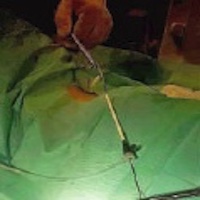Non-invasive removal of self-locking entrapped nephrostomy tubes

Accepted: March 16, 2020
All claims expressed in this article are solely those of the authors and do not necessarily represent those of their affiliated organizations, or those of the publisher, the editors and the reviewers. Any product that may be evaluated in this article or claim that may be made by its manufacturer is not guaranteed or endorsed by the publisher.
Introduction: The removal of an encrusted nephrostomy tube can be a challenging maneuver. Urological literature is very bare in detailing techniques for removal of entrapped percutaneous catheters. We present a simple, safe and non-invasive technique of nephrostomy removal using a vascular introducer sheath, useful to manage complicated situations such as nephrostomies blocked for severe encrustations or disabled in their self-locking system.
Surgical technique: The nephrostomy tube is cut and the stump is passed with a suture needle. The suture is passed through the inner vascular introducer sheath tip, and the introducer is then removed. The introducer sheath is advanced over the nephrostomy until joining the pigtail segment, under fluoroscopy guidance. Thus the suture is pulled out with strenght to contrast the opposite stiffness of the encrusted coil, until the nephrostomy has safely come out.
Comment: The sheath exchange technique is quick, involves less manipulation through the perirenal fascia and kidney, and is suitable for different conditions of entrapped nephrostomies.
Alnadhari I, Alwan MA, Salah MA, Ghilan AM. Treatment of retained encrusted ureteral Double-J stent. Arch Ital Urol Androl 2019; 18;90:265-269. DOI: https://doi.org/10.4081/aiua.2018.4.265
Canby-Hagino ED, Caballero RD, Harmon WJ. Intraluminal pneumatic lithotripsy for the removal of encrusted urinary catheters. J Urol 1999;162:2058-60. DOI: https://doi.org/10.1016/S0022-5347(05)68100-1
Mangera A, Mehta S, Hastie KJ, Salim F, Hall J. Lithoclast removal of an encrusted nephrostomy tube . Ann R Coll Surg Engl 2010;92:353-4. DOI: https://doi.org/10.1308/rcsann.2010.92.4.353
Baron RL, McClennan BL. Replacing the occluded percutaneous catheter. Radiology 1981;141:824. DOI: https://doi.org/10.1148/radiology.141.3.7302241
Pollack Hl, Banner MP. Replacing blocked or dislodged percutaneous nephrostomy and ureteral stent catheters. Radiology 1982;145:203-5. DOI: https://doi.org/10.1148/radiology.145.1.7122880
Farooq A, Agarwal S, Vaughan J. Safe removal of an ecrusted nephrostomy tube using a vascular sheath: a technique revisited. Cardiovasc Intervent Radiol 2013;36:820-3. DOI: https://doi.org/10.1007/s00270-013-0572-8
Rossi UG, Rollandi GA, Ierardi AM, et al. Materials and techniques for percutaneous retrieval of intravascular foreign bodies. J Vasc Access 2019;20:87-94. DOI: https://doi.org/10.1177/1129729818785051
PAGEPress has chosen to apply the Creative Commons Attribution NonCommercial 4.0 International License (CC BY-NC 4.0) to all manuscripts to be published.


 https://doi.org/10.4081/aiua.2020.3.207
https://doi.org/10.4081/aiua.2020.3.207



